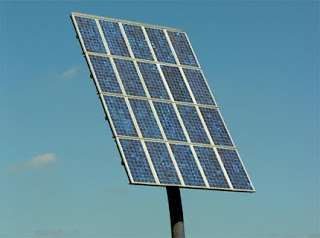 1. Why should I consider using solar?
1. Why should I consider using solar? When the sun shines, you get power! No muss. No fuss. It's absolutely silent, and it's pretty much maintenance-free. All I (Libbie) do aboard s/v HOTWIRE is use a damp sponge or rag once in a while to wipe off dust, salt, and bird poop!
Where we are now, I clean ours a couple of times a year. When we were downwind from the cement plant at Puerto la Cruz, Venezuela, I cleaned them much more often. The cleaner the surface, the better it works for you.
2. Which kind should I buy?
There are basically 3 technologies to choose from:
- monocrystal (high output) -- the most efficient
- polycrystal (high output) -- almost as efficient as monocrystal
- thin film / amorphous (heat- and shade-tolerant) -- less efficient
Which type you should use depends on where you plan to install it. They all perform their best in full sun.
 3. Where should I install solar on my boat?
3. Where should I install solar on my boat?
In order of choice, we find that the best place aboard is high & aft, above davits or on top of an arch, where shadows are less likely (we have the mounting hardware for you).
If you can put solar up there, by all means go with a high output technology! Get the biggest bang for your buck! (Just don't put solar under a wind generator or radar shadow. If you must, I'd recommend a shade tolerant technology.)
A fixed mount above a bimini works well if there is bimini surface aft of the boom. Again, go with high output. And you get the added advantage that the solar modules shadow the bimini and keep the cockpit cooler! (Contact us for design advice for increasing bimini strength.)
Another choice is on a rail at or near the stern. If there will be few shadows, choose a high output technology. If shadows are likely most of the time, go with a shade tolerant module.
Above the dodger, you have a couple of options:
- A high output module on each side of the boom will usually guarantee that at least one of them will be in full sun; and at anchor, you can settle the boom to one side or the other for maximum sun exposure. If one solar cell is fully shadowed, you're down to 50% power output. If a whole row of cells is shadowed, you're getting nothing.
- A shade tolerant module on each side of the boom will give you charging capability even when a portion of the surface is shadowed. The percentage of output is equal to the percentage of surface exposed to sun. When 40% is shadowed and 60% is in the sun, you'll get 60% of the rated capacity of output.
4. What makes the monocrystal and polycrystal output drop so much in shadows?
 The high output modules have individual cells, and each cell can be thought of as a small battery. When you shade one cell, it's like taking a battery out of the (series) circuit. Think of the old Christmas tree lights - when one went out they all did. Thin film modules don't have individual cells, it's more like one big cell.
The high output modules have individual cells, and each cell can be thought of as a small battery. When you shade one cell, it's like taking a battery out of the (series) circuit. Think of the old Christmas tree lights - when one went out they all did. Thin film modules don't have individual cells, it's more like one big cell.
The larger high output modules also have a bypass diode so that the cells are essentially divided into two separate circuits. When one cell in one of the circuits is shadowed, that whole circuit is down. But because the disabled circuit can be bypassed, the other circuit can still function.
5. Why would anybody buy such shade-sensitive stuff?
They're much higher output than shade-tolerant modules. Shell has a 55 watt monocrystal module that's in the exact same frame as their 40 watt shade-tolerant module! On a sailboat, space is an issue. I want more power from the space the module will occupy!
6. If monocrystal is the most efficient, why would I even think about buying polycrystalline?
They come in different shapes and sizes. The difference in efficiency is small enough that available space is the more important issue here. Measure your space and choose the module that fits best.
The most popular polycrystaline (Kyocera) tend to be more square, while the most popular mono-crystal (Shell) tend to be more rectangular.
Also, some polycrystaline modules such as those made by Solara, are thin, lightweight and flexible. They designed to be glued or screwed to the deck of your boat, giving you more options in positioning and mounting panels.
7. What's the difference between solar cell, solar panel, and solar module?
The solar cell is one small (approx. 4"x4") area on the surface of a solar module. The module is made up of many solar cells set into a frame for support. A solar panel is several solar modules installed together on a rack. Put some racks together and you have a solar array.

No comments:
Post a Comment